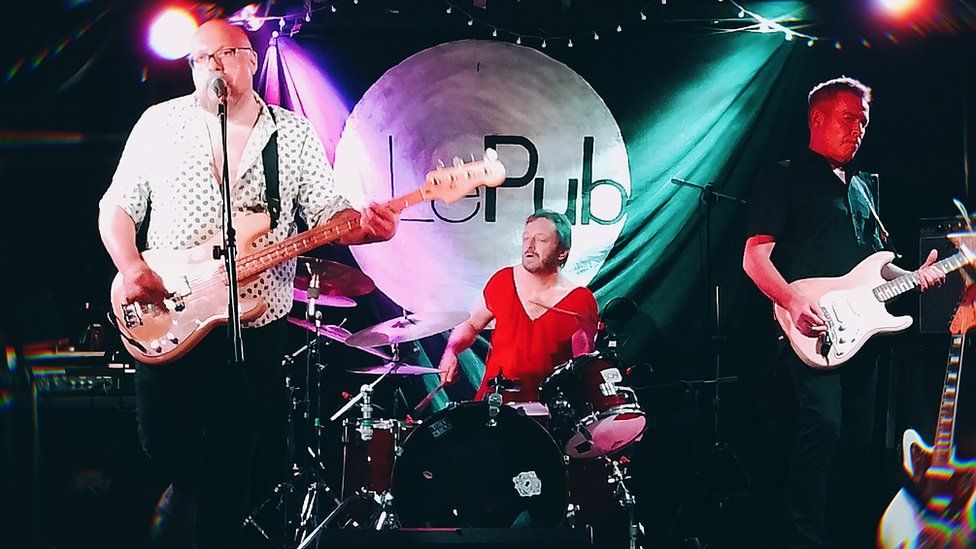Alcoholic sucked spilled pint from filthy pub carpet
Alcoholic sucked spilled pint from filthy pub carpet BBC


‘Moment of epiphany’
A recovering alcoholic has recalled the time he drank a spilled pint from a “filthy” pub carpet with a straw.
Sustainable Development Goals (SDGs)
- Goal 3: Good Health and Well-being
Gene Davies, from Cwmaman, Rhondda Cynon Taf, said he was at his lowest ebb after developing a drink problem in his early teens.
The 50-year-old said his addiction grew as a result of performing in bands at various workingmen’s clubs across south Wales.
Now five years sober, he wants to share his story to warn others.
Some 45% of men and 34% of women report drinking above the recommended guidelines, according to statistics from Public Health Wales.
Alcohol is also the cause of around 1,500 deaths a year, with the rate higher in the most deprived areas of Wales.
“Growing up in the valleys during the ’80s, it was surprisingly easy to get served whilst underage,” said Gene, who started out playing drums in a group called Silent Runner alongside Kelly Jones from Stereophonics.
“We’d end up necking flagons of lager while the bar staff turned a blind eye, and the rock and roll showman in me probably meant I put away more than most.”
He said he would stash bottles around the family home so his parents wouldn’t realise the extent of his problem, often taking long walks alone in order to indulge his habit.
Eventually kicked out of university for non-attendance and fired from a number of odd jobs, he continued to throw himself into his music.
Related Topics
‘Everyone is different’
“It’s the same faces all the time; morning, noon and night – some even ask me my advice on how to quit,” he said.
“I’m never sure what to say to them though.
“Everyone is different and only they can know when it’s their time to stop.
“They just need to decide if it’s something they can do themselves or with the help of others.”
Has he ever been tempted to relapse himself?
“No, from the moment I stopped I just realised I was done with all that,” he said.
“I don’t miss it a bit – not the taste and certainly not the hangovers.”
Gene’s journey to recovery

Gene Davies, a recovering alcoholic, has shared his journey to recovery and sobriety. He grew up in the valleys of Wales during the ’80s, where it was easy for him to get served alcohol while underage. His addiction grew as he performed in bands at workingmen’s clubs. After hitting rock bottom, he decided to quit drinking and has been sober for five years. Gene now works at a newsagents and off licence, where he encounters others struggling with addiction. He believes that everyone’s journey to recovery is different and that individuals must decide for themselves when it’s time to stop.
Moment of Epiphany

Gene’s “moment of epiphany” came when he fell out of a bunkbed while drunk and injured himself. He had been kicked out of his house due to his drinking and was lodging with a friend. The fall caused him to realize the extent of his problem and he decided to quit drinking. Since then, he has not touched alcohol and has focused on being the best father to his seven-year-old son and improving his musical abilities.
Gene’s Transformation

Gene’s transformation has been remarkable. He has completely turned his life around and is now focused on his family and music. He no longer misses alcohol and is grateful that those times are behind him.
If you have been affected by any of the issues in this story, the BBC Action Line has links to organizations which can offer support and advice.
SDGs, Targets, and Indicators
1. No Poverty
- Target 1.4: By 2030, ensure that all men and women, in particular, the poor and the vulnerable, have equal rights to economic resources, as well as access to basic services, ownership, and control over land and other forms of property, inheritance, natural resources, appropriate new technology, and financial services, including microfinance.
- Indicator 1.4.2: Proportion of total adult population with secure tenure rights to land, with legally recognized documentation and who perceive their rights to land as secure, by sex and by type of tenure.
3. Good Health and Well-being
- Target 3.5: Strengthen the prevention and treatment of substance abuse, including narcotic drug abuse and harmful use of alcohol.
- Indicator 3.5.2: Harmful use of alcohol, defined according to the national context as alcohol per capita consumption (aged 15 years and older) within a calendar year in liters of pure alcohol.
5. Gender Equality
- Target 5.4: Recognize and value unpaid care and domestic work through the provision of public services, infrastructure, and social protection policies and the promotion of shared responsibility within the household and the family as nationally appropriate.
- Indicator 5.4.1: Proportion of time spent on unpaid domestic and care work, by sex, age, and location.
10. Reduced Inequalities
- Target 10.2: By 2030, empower and promote the social, economic, and political inclusion of all, irrespective of age, sex, disability, race, ethnicity, origin, religion, or economic or other status.
- Indicator 10.2.1: Proportion of people living below 50 percent of median income, by age, sex, and persons with disabilities.
16. Peace, Justice, and Strong Institutions
- Target 16.1: Significantly reduce all forms of violence and related death rates everywhere.
- Indicator 16.1.2: Conflict-related deaths per 100,000 population, by sex, age, and cause.
Analysis
1. The SDGs addressed or connected to the issues highlighted in the article are:
– No Poverty (SDG 1)
– Good Health and Well-being (SDG 3)
– Gender Equality (SDG 5)
– Reduced Inequalities (SDG 10)
– Peace, Justice, and Strong Institutions (SDG 16)
2. Specific targets under those SDGs based on the article’s content are:
– Target 1.4: Ensuring equal rights to economic resources and access to basic services.
– Target 3.5: Strengthening the prevention and treatment of substance abuse.
– Target 5.4: Recognizing and valuing unpaid care and domestic work.
– Target 10.2: Empowering and promoting social, economic, and political inclusion.
– Target 16.1: Significantly reducing all forms of violence and related death rates.
3. Indicators mentioned or implied in the article that can be used to measure progress towards the identified targets are:
– Indicator 1.4.2: Proportion of total adult population with secure tenure rights to land.
– Indicator 3.5.2: Harmful use of alcohol, measured as alcohol per capita consumption.
– Indicator 5.4.1: Proportion of time spent on unpaid domestic and care work.
– Indicator 10.2.1: Proportion of people living below 50 percent of median income.
– Indicator 16.1.2: Conflict-related deaths per 100,000 population.
4. Table presenting the findings:
| SDGs | Targets | Indicators |
|———————————|———————————-|———————————-|
| No Poverty (SDG 1) | Target 1.4 | Indicator 1.4.2 |
| Good Health and Well-being (SDG 3) | Target 3.5 | Indicator 3.5.2 |
| Gender Equality (SDG 5) | Target 5.4 | Indicator 5.4.1 |
| Reduced Inequalities (SDG 10) | Target 10.2 | Indicator 10.2.1 |
| Peace, Justice, and Strong Institutions (SDG 16) | Target 16.1 | Indicator 16.1.2 |
Behold! This splendid article springs forth from the wellspring of knowledge, shaped by a wondrous proprietary AI technology that delved into a vast ocean of data, illuminating the path towards the Sustainable Development Goals. Remember that all rights are reserved by SDG Investors LLC, empowering us to champion progress together.
Source: bbc.com

Join us, as fellow seekers of change, on a transformative journey at https://sdgtalks.ai/welcome, where you can become a member and actively contribute to shaping a brighter future.







